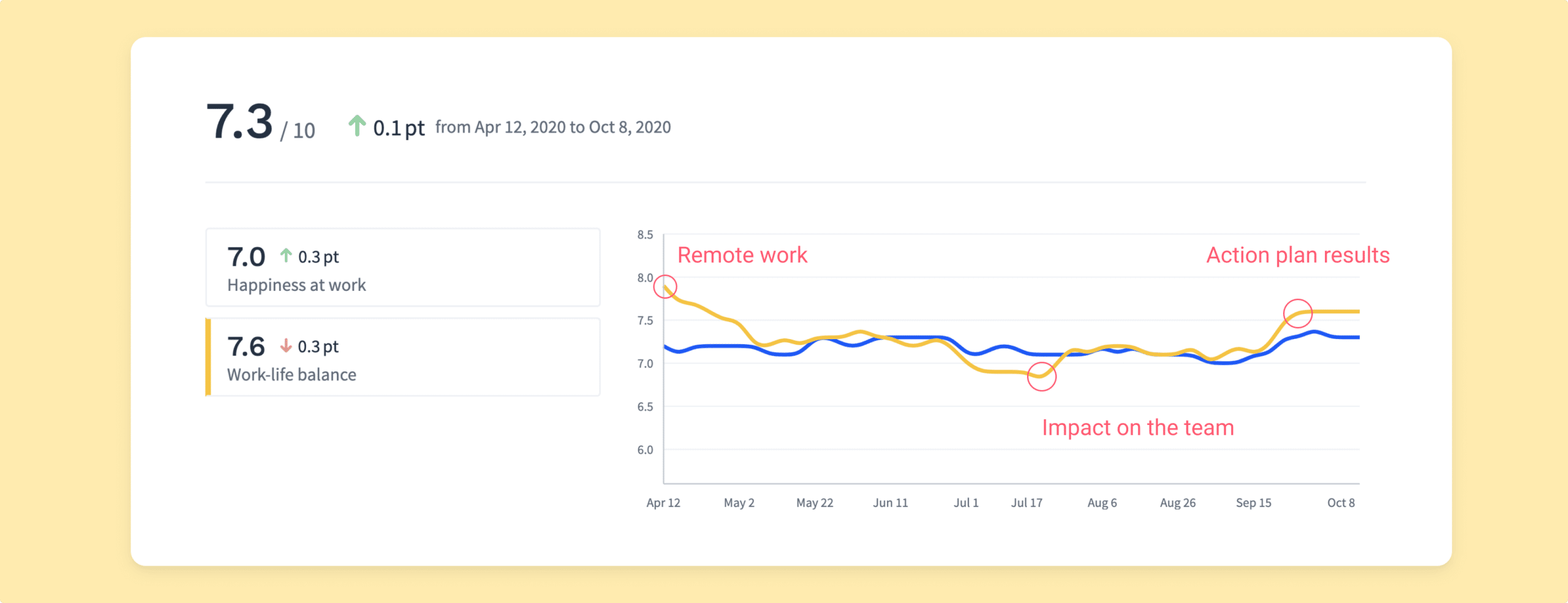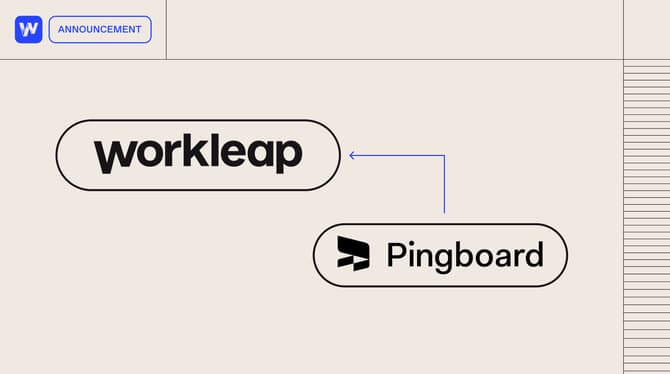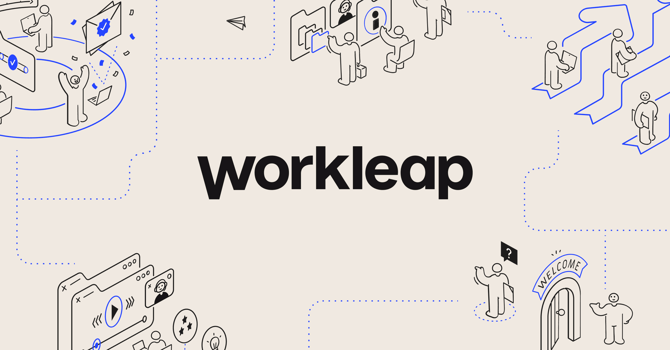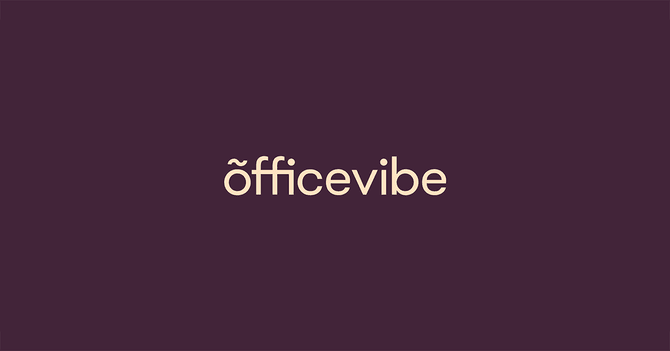The intrigue around how managers and their teams are approaching the topic of workplace well-being has increased over the last year. It’s no secret that there’s a strong correlation between teams who prioritize emotional, physical and mental well-being, and impactful work. Ultimately it boils down to learning the warning signs pointing towards your teams well-being. Remember, managers need to support employees and learn helpful, applicable methods for a healthy team.
In fact 39% of Officevibe users have expressed that their work is taking a negative toll on their work related stress level.
It’s never too late to do something good for yourself, and for your team. We’re exploring: what it means for managers to prioritize employee well-being, and how to do so while also improving employee engagement.
Workleap is making work simpler, kinder, and faster.

In this article you'll:
How to understand the main causes of stress and overwhelm
Our team experienced indications of high stress this past spring with the onset of remote work becoming the norm. Without skipping a beat, this prompted us to pivot into action.

Our senior leadership team decided it was paramount for us to walk the talk and use Officevibe’s pulse survey tool to check-in with our team. Using the data we gathered, it was clear that there were several key contributors linked to low employee engagement and employee well-being.
Here’s how we got to the bottom of stress on our teams:
1. Listen and understand
Properly understand the situation. Identify which factors are contributing to employee stress. (We used our Custom Poll templates dedicated to wellness to easily survey our teams).
2. Offer visibility on results
Share the results with everyone to provide a sense of transparency. It's important for us to have each employee give their input on concrete action items.
3. Make action planning collaborative
Brainstorm on action items as a team, allowing each employee to be part of the solution. In our case, each one of us had access to a shared Miro board. Here, all the main topics and ideas from the Custom Poll were gathered. Each employee could then participate by owning their schedule, comment, and discuss specific ideas on the board.
4. Give employees a say in the next steps
Let every employee vote on the action items they feel would most benefit the stress and wellness levels of the company.
5. Commit to next steps
Results of the vote demonstrated concrete areas where we could concentrate our efforts. We agreed to action out each of these. This included:
- A time management workshop to amplify mental well-being
- Employee fitness challenge
- A team-based company virtual event (we chose a murder mystery party)
- A commitment to achieve strategic objectives
- Keeping track of progress: Measure the change you implement. You can do this with our simple Officevibe Pulse Surveys that track metrics like “Wellness”
As we put our people-first approach into action, we quickly turned things around. We came up with solutions that fit our needs and increased workplace well-being. Taking the time to listen to employees via our pulse surveys, then following up with deeper and more meaningful discussions in 1-on-1s let them know that we support each other.
❤️ Check out our full team story here!
The TLDR on learning about the state of your team’s wellbeing:
- Identify the situation at hand and show initiative around prioritizing the wellbeing of you and your team.
- Be open minded and share results to further understand how you can collectively shift perspectives and make things better.
- Collaborate in a brainstorm session and explore key areas that will benefit your team's physical and mental health.
- Collectively commit to action items, making them habitual, fun, and cost effective
5 tips to help you build a workplace well-being program
Our recent Officevibe survey results found that 22% of employees feel as though their work is taking a toll on their personal lives. When we take a closer look, it’s noticeable how remote work plays an important role in this data. After all, we are no longer working from home, rather, living at work.
Societal norms condition us to think that taking care of our well-being is a luxury and that work-related stress is “normal.” Emotional Intelligence experts at Roche Martin indicated that promoting well-being within teams increases productivity and motivation, builds morale, and decreases work-related stress.
How can managers find applicable solutions as a team to make things better?
Lead by example
Deconstruct preconceived stigmas around keeping emotions to yourself. Encourage teams to talk about how they feel. Start by being vulnerable about what has been most stressful for you.
Brainstorm together
Facilitate a brainstorming session with remote collaboration tools (like Miro). Express ideal states of well-being and how that is defined by the team.
Get creative
Let them know that nothing is off the table. Encourage creativity on your team to achieve a state of well-being for a more balanced approach to their day-to-day.
Experiment with what works, then iterate
Set the baseline that it’s okay if you don’t get it right on the first try. Create a guiding north star of what is the best possible outcome, and break this down into smaller achievable well-being initiatives to test over time.
Keep it human
Our poll results demonstrate that 16% of users feel as though someone would not say or do something helpful if they noticed they were in a state of distress. Taking time to intentionally connect with one another not only helps for accountability, it builds connection, trust, and psychological safety.
We all want to see each other succeed, luckily there are several ways to let teams know that you value their overall health and find ways to encourage them towards a more balanced life.
The TLDR on finding solutions to team stress
- Your team’s wellbeing is urgent: prioritize collaborative brainstorm sessions and explore existing sentiments, resources that are available to help team members and healthy habits to integrate.
- Try it out for size: be flexible in your experimentation of what works and what doesn’t work and encourage teams to share feedback.
- Encourage connections with team members: create accountability buddies.
How to build workplace well-being habits that last & drive continuous performance
We’ve learned the root causes and concerns around employee isolation, overwhelm, and stress and how this can be amplified in a remote environment. We also took a look at how we can create a shift in perspective that works for teams. It’s time to understand how to keep the focus on well-being as a priority and make that a long-lasting value.
66% of Officevibe users feel as though their company offers the support they need to deal with work-related stress
It’s no wonder that those who feel this level of support have seen a boost in engagement and productivity. Yet, well-being is not a one-stop- shop, nor is it one-size-fits-all. It's a habit that needs to be baked into everyday expectations.

During times of crisis or uncertainty, employees crave the following:
Stability
We tend to cling on to sensations of stability in times of high stress. A manager can integrate a sense of stability in a state of flux by keeping 1-on-1 meetings consistent. This way, employees know they have a consistent touchpoint with their manager.
Clarity and visibility
Over-communicate and clarify expectations often. Offer visibility to your team as often as possible when it comes to shifts in strategy or changes in the business. Be clear on how this affects them.
Flexibility
Learn what flexibility means to your team, and how you can help facilitate their well-being by being open about meeting schedules, deadlines, and big projects. Find a system that adheres to healthy habits and fosters creativity, growth, and development.
Appreciation
Celebrate small wins. Recognize employees who offer a helping hand to others who might be struggling with stress, amplifying that we are all in this together.
The TLDR on making wellbeing habitual:
- Foster a sense of stability with your team’s day to day
- Define flexibility and stick to that as a team principal
- Encourage healthy habits outside of work: daily walks, accountability groups, gratitude lists, etc
- Build recognition and trust within your team
Keeping our well-being at the heart of what we do allows our team to bring a human approach to our teams and our projects. When we prioritize our health, we feel supported. Understanding the resources available to us enables us to feel a sense of calm in the eye of the storm.
These habits are proven to have massive impacts on companies with a positive culture. Remember that it doesn’t have to be complex, simplicity is key, all it takes is someone to listen and lead.
Equip HR and managers with tools to engage, recognize, and drive performance.




